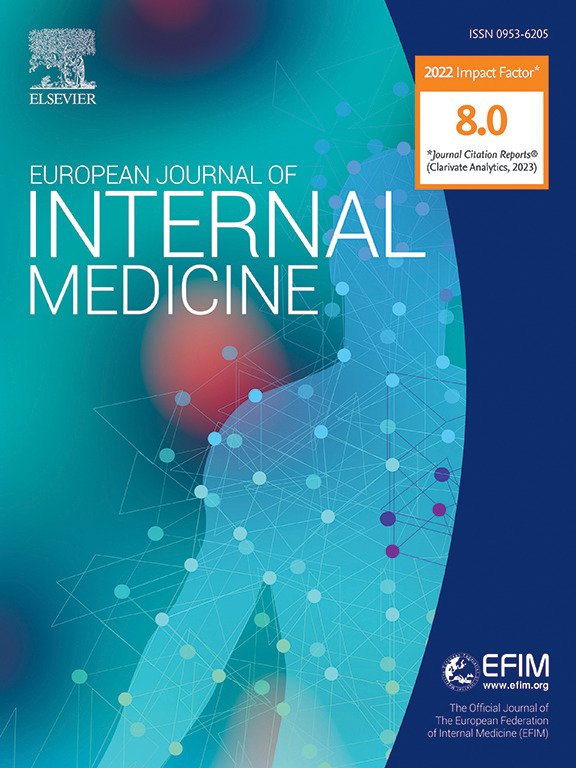Effects of population-based screening for atrial fibrillation on quality of life
IF 5.9
2区 医学
Q1 MEDICINE, GENERAL & INTERNAL
引用次数: 0
Abstract
Background
Screening for atrial fibrillation is rising and may worsen or improve quality of life.
Methods
We assessed quality of life (EQ-5D-5L) data in 6,004 participants with stroke risk factors randomised to usual care (n=4,503) or implantable loop recorder with anticoagulation upon detection of atrial fibrillation (n=1,501). Five domains (mobility, selfcare, usual activities, pain/discomfort, anxiety/depression) each scored from one to five were calculated into individual index scores (worst=-0.76, best=1.00). Changes in the index score and the visual analogue scale score (EQ VAS (0=worst, 100=best)) from baseline to year three were the primary outcomes, which were analysed using linear mixed models. Major problem was defined as a domain score ≥3 and analysed with logistic regression in year three.
Results
Of 6,004 participants, 5,733 (95 %) were alive after three years, and 5,162 (86 %) had complete EQ-5D-5L data. The baseline index score of 5,733 participants was 0.88 ±0.16, which decreased by -0.05 (-0.05; -0.04) in the control vs -0.04 (-0.05; -0.03) in the screening group after three years, and a baseline EQ VAS score of 78.4±16.2, which decreased by -6.06 (-6.54; -5.57) in control vs -5.18 (-5.95; -4.40) in the screening group after three years, with no significant difference between the groups (p=0.063 and p=0.056, respectively). The most frequent problem was major pain/discomfort (1,202 of 5,162 (23.3 %)), and any major problem occurred equally in the groups after three years (OR 0.91 (0.79;1.05)).
Conclusion
A population-based, long-term, and continuous screening for atrial fibrillation in high-risk individuals did not translate into increased quality of life.

基于人群的房颤筛查对生活质量的影响。
背景:房颤的筛查正在增加,可能会恶化或改善生活质量。方法:我们评估了6,004名卒中危险因素参与者的生活质量(EQ-5D-5L)数据,这些参与者随机分为常规治疗组(n=4,503)或检测到房颤后带有抗凝功能的植入式循环记录仪组(n=1,501)。五个领域(活动能力、自我护理、日常活动、疼痛/不适、焦虑/抑郁)的得分从1到5计算成个人指数得分(最差=-0.76,最好=1.00)。指标评分和视觉模拟量表评分(EQ VAS(0=最差,100=最好))从基线到第三年的变化是主要结果,使用线性混合模型进行分析。主要问题定义为领域得分≥3,并在第三年进行逻辑回归分析。结果:在6004名参与者中,5733名(95%)在三年后存活,5162名(86%)具有完整的EQ-5D-5L数据。5733名受试者的基线指标得分为0.88±0.16,下降了-0.05 (-0.05;-0.04) vs -0.04 (-0.05;-0.03),基线EQ VAS评分为78.4±16.2,下降了-6.06 (-6.54;-5.57) vs -5.18 (-5.95;-4.40),组间差异无统计学意义(p=0.063, p=0.056)。最常见的问题是严重的疼痛/不适(5162人中有1202人(23.3%)),三年后各组的严重问题发生率相同(OR 0.91(0.79;1.05))。结论:对高危人群进行基于人群的、长期的、持续的房颤筛查并不能提高生活质量。
本文章由计算机程序翻译,如有差异,请以英文原文为准。
求助全文
约1分钟内获得全文
求助全文
来源期刊
CiteScore
9.60
自引率
6.20%
发文量
364
审稿时长
20 days
期刊介绍:
The European Journal of Internal Medicine serves as the official journal of the European Federation of Internal Medicine and is the primary scientific reference for European academic and non-academic internists. It is dedicated to advancing science and practice in internal medicine across Europe. The journal publishes original articles, editorials, reviews, internal medicine flashcards, and other relevant information in the field. Both translational medicine and clinical studies are emphasized. EJIM aspires to be a leading platform for excellent clinical studies, with a focus on enhancing the quality of healthcare in European hospitals.

 求助内容:
求助内容: 应助结果提醒方式:
应助结果提醒方式:


